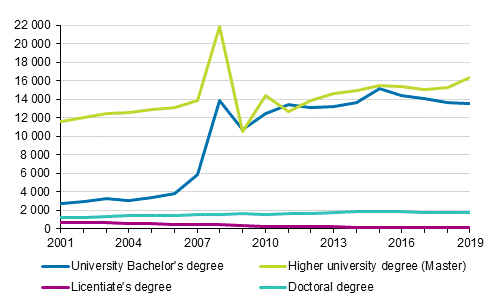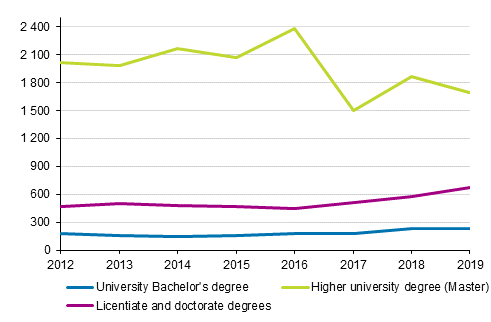This set of statistics has been discontinued.
Statistical data on this topic are published in connection with another set of statistics.
Data published after 5 April 2022 can be found on the renewed website.
Published: 13 May 2020
Number of university degrees began to grow
The number of completed university degrees started to grow in 2019 after three successive years of decline. In 2019, a total of around 31,700 university degrees were completed in Finland, which is around 900 more than one year earlier. The rise in the number of degrees focused on higher university degrees, whose number (good 16,000) went up by good one thousand. These data derive from Statistics Finland’s education statistics.
Number of university degrees in 2001 to 2019

Number of completed doctorate degrees fell
The number of completed lower university degrees was good 13,500 in 2019, which is slightly lower than one year earlier. Around 1,700 students completed doctorate degrees. The number has fallen by around 70 from the previous year, and compared to the peak year 2015, the number of those having defended their doctorate thesis fell by around 160 in 2019. In 2019, altogether 79 students completed a licentiate degree, which is four more than one year before.
Women completed the majority of university degrees, nearly 60 per cent. The share was on level with the previous year.
Foreign students completed around eight per cent of the degrees in 2019. Their proportion is the same as in the previous year. One in four of the doctorate degrees were completed by a foreign citizen.
Most degrees, good 6,100, were completed at the University of Helsinki. Over 3,500 degrees were also attained at the University of Tampere, Aalto University and the University of Turku. The smallest universities based on the number of degrees were the National Defence University (around 350 degrees) and the University of the Arts Helsinki (UniArts) (about 550 degrees).
The most common content for completed degrees was trade, administration and law, in which field around 18 per cent of students graduated. Degrees attained in humanities and arts made up 16 per cent of all degrees and degrees attained in technology 14 per cent. Among those who were doctorate holders, the most common contents of education were health and welfare (one in four of those who were doctorate holders) and technology (nearly one in five of those who were doctorate holders).
Number of new students grew
Around 27,000 new students began their university studies in 2019. The number is nearly 800 students higher than one year earlier. In particular, the number of doctorate students rose clearly. In 2019, the number of students starting doctorate studies was good 2,100, which was around 400 more than in 2018.
The number of new foreign students remained almost on level with 2018, at around 2,600 persons. For them, the number of students having started studies leading to a higher university degree fell, but the number of those studying for a doctorate degree went up correspondingly.
New foreign university students in 2012 to 2019

In 2019 the number of students attending university education leading to a degree was close on 154,000, which is around 350 more than in 2018. There were around 77,000 students studying for a lower university degree and about 58,000 persons studying for a higher university degree. Some 18,500 students studied in education leading to a post-graduate degree, around 700 of whom were studying for a licentiate's degree and around 18,000 for a doctor's degree. Women made up 54 per cent of all students.
The highest numbers of university students were studying in the fields of business, administration and law, and humanities and arts, around 17 per cent of all university students. Around 15 per cent of them studied in the field of technology. Women studied clearly more often than men in the fields of education (eight out of ten were women), arts and humanities, health and welfare, and social sciences, journalism and information (seven out of ten were women). Men, in turn, studied more often than women in the fields of information and communication technologies (eight out of ten were men), services and engineering, manufacturing and construction (seven out of ten were men).
In 2019, the University of Helsinki had clearly the highest number of students, around 31,600. The next biggest universities by the number of students were the University of Tampere (close on 21,000 students) and Aalto University (close on 18,000 students). More detailed time series data on university students and degrees by education and university are available in the database tables .
Source: Education. Statistics Finland
Inquiries: Timo Ruuskanen 029 551 3620, koulutustilastot@stat.fi
Director in charge: Jari Tarkoma
Publication in pdf-format (281.8 kB)
- Tables
-
Tables in databases
Pick the data you need into tables, view the data as graphs, or download the data for your use.
Appendix tables
- Appendix table 1. Students in universities and completed university degrees by level of education, fields of education (National classification of education 2016) and gender in 2019 (13.5.2020)
- Appendix table 2. Foreign students in universities and completed university degrees by level of education, fields of education (National classification of education 2016) and gender in 2019 (13.5.2020)
Updated 13.5.2020
Official Statistics of Finland (OSF):
University education [e-publication].
ISSN=2324-0148. 2019. Helsinki: Statistics Finland [referred: 20.4.2025].
Access method: http://stat.fi/til/yop/2019/yop_2019_2020-05-13_tie_001_en.html

